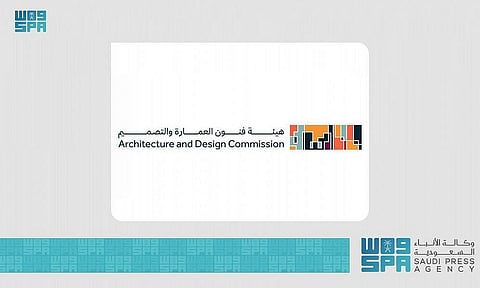

The Architecture and Design Commission launched on Thursday its comprehensive strategy towards developing the Saudi architecture and design sector, taking it to new horizons that promote creativity and enable sector practitioners.
Inspired by "Al-Murabba Palace," the commission presents its strategy titled "Al-Murabba" to reflect its ambitions to formulate a renewed and modern starting point for the Saudi urban and design scenes, transcending traditional borders and serving the sector's practitioners with various initiatives and programs.
CEO of the Architecture and Design Commission Dr. Sumayah Al-Solaiman indicated that the strategy attended comprehensively to the architecture and design sector, seeking to grow and integrate it, support its practitioners, and ascend it to the aspirations of the Ministry of Culture under the leadership of Prince Badr bin Abdullah bin Farhan.
Al-Solaiman pointed out that the strategy includes multiple dimensions and factors, including legislative and regulatory aspects, support and empowerment, and the development of the sector-related educational and practical environments, in addition to an assortment of programs and initiatives supporting practitioners of architecture and design around the Kingdom of Saudi Arabia.
The Architecture and Design Commission identified its "North Star" statement that supports the development and empowerment of the sector: "We seek to support excellence in the architecture and design ecosystem, shaped by our culture, re-imagined by our ambitions, and empowered by local talent, to improve the lives of our communities while being at the forefront of the global creative scene."
As a first step, the commission has re-interpreted the definition of the sector and identified its six sub-sectors as "the creative expression of designing the built environment, products and communicating ideas with aesthetic and functional value, and includes the disciplines of architecture, interior design, urban planning/urban design, landscape architecture, graphic design, and industrial design, as well as all activities, professions, products, and services related to these practices."
To reach the North Star, the Architecture and Design Commission identified six ambitious strategic objectives: developing the sector by promoting integration in the architecture and design ecosystem, contributing to the gross domestic product (GDP) by growing the creative industries and design services sector, developing the talents of current and future professionals, gaining global recognition for architecture and design in the Kingdom of Saudi Arabia, achieving environmental sustainability in the built environment, and creating a local community of research and innovation in the architecture and design sector.
In alignment with the strategy to be implemented in the next five years, the commission will present 33 initiatives under 6 programs to achieve its strategic objectives.
The first program, "Regulating the Architecture and Design Sector," is concerned with setting regulations and guidelines for professional and commercial practices in the sector. It includes two initiatives: "Architecture and Design Policy Development" and the sector's "Academic Development."
The second program, "Developing the Architecture and Design Sector," sparks sector development and enables practitioners to impact the architecture and design community significantly. It includes 7 initiatives: "King Salman Charter for Architecture and Urbanism," "Designed in Saudi" initiative, "Architecture and Design Sector Professional Associations," "Architecture and Design Sustainability Task Force and Summit," "Cultural Assets Enrichment," "Urban Transformation" and the "Center for Arabic Typography."
The third program, "Education and Professional Development," is dedicated to supporting the architects and designers in their journey from primary education to professional excellence. It includes 7 initiatives: "Youth Creativity Development," "Internship and advisory programs," "Continuous Professional Development," "Educational Enrichment Programs," "Architecture and Design Incubators and Accelerators," "National Architecture and Design Digital Platforms," and the "Najdi Architecture Academy."
The fourth program, "Content Development," focuses on developing, creating and promoting cultural content on architecture and design to enrich cultural practices. It includes 8 initiatives: "Architecture and Design Research Strategy," "National Center for Documentation of Architecture and Design," "Architectural Tourism," "Documenting KSA Regional Identities," "Encyclopedia of Architecture and Design," "Audiovisual Content Development," "Architecture and Design Museum," and "Design Magazine of Saudi Arabia."
The fifth program focuses on public engagement and communication. It mainly focuses on a calendar of cultural events and the Architecture and Design Commission's awards targeting the local and international communities. It includes 4 strategic initiatives serving the architecture and design sectors: "Competitions and Awards," "Design for Good," "Design Days," and "DESIGNathon."
The sixth and final program, "Activating the Architecture and Design Commission," is dedicated to activating the commission, focusing on communication and internal initiatives to implement the operational model. It includes 5 initiatives: "Operating Model Ramp-up," "Communication Strategy within the commission," "Architecture and Design Market Research," "Strategic Partnerships Activation," and "Architecture and Design Practitioner and Firm Registration."
As one of 11 cultural commissions affiliated with the Ministry of Culture, and in light of the strategy, the Architecture and Design Commission is devoted to carrying out its responsibilities towards developing and promoting the sector, supporting its practitioners and achieving the cultural goals in alignment with the Ministry's objectives and the Saudi Vision 2030 on a broader perspective in the Kingdom of Saudi Arabia.
